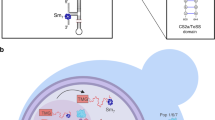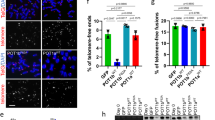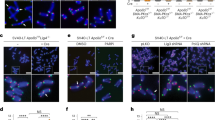Abstract
Telomeres are the physical ends of eukaryotic chromosomes. Genetic studies have established that the baker's yeast Pif1p DNA helicase is a negative regulator of telomerase, the specialized reverse transcriptase that maintains telomeric DNA, but the biochemical basis for this inhibition was unknown. Here we show that in vitro, Pif1p reduces the processivity of telomerase and releases telomerase from telomeric oligonucleotides. The released telomerase is enzymatically active because it is able to lengthen a challenger oligonucleotide. In vivo, overexpression of Pif1p reduces telomerase association with telomeres, whereas depleting cells of Pif1p increases the levels of telomere-bound Est1p, a telomerase subunit that is present on the telomere when telomerase is active. We propose that Pif1p helicase activity limits telomerase action both in vivo and in vitro by displacing active telomerase from DNA ends.
This is a preview of subscription content, access via your institution
Access options
Subscribe to this journal
Receive 51 print issues and online access
$199.00 per year
only $3.90 per issue
Buy this article
- Purchase on Springer Link
- Instant access to full article PDF
Prices may be subject to local taxes which are calculated during checkout




Similar content being viewed by others
References
Marcand, S., Brevet, V., Mann, C. & Gilson, E. Cell cycle restriction of telomere elongation. Curr. Biol. 10, 487–490 (2000)
Diede, S. J. & Gottschling, D. E. Telomerase-mediated telomere addition in vivo requires DNA primase and DNA polymerases alpha and delta. Cell 99, 723–733 (1999)
Taggart, A. K. P., Teng, S.-C. & Zakian, V. A. Est1p as a cell cycle-regulated activator of telomere-bound telomerase. Science 297, 1023–1026 (2002)
Fisher, T. S., Taggart, A. K. P. & Zakian, V. A. Cell cycle-dependent regulation of yeast telomerase by Ku. Nature Struct. Mol. Biol. 11, 1198–1205 (2004)
Schramke, V. et al. RPA regulates telomerase action by providing Est1p access to chromosome ends. Nature Genet. 36, 46–54 (2004)
Schulz, V. P. & Zakian, V. A. The Saccharomyces PIF1 DNA helicase inhibits telomere elongation and de novo telomere formation. Cell 76, 145–155 (1994)
Zhou, J.-Q., Monson, E. M., Teng, S.-C., Schulz, V. P. & Zakian, V. A. The Pif1p helicase, a catalytic inhibitor of telomerase lengthening of yeast telomeres. Science 289, 771–774 (2000)
Mangahas, J. L., Alexander, M. K., Sandell, L. L. & Zakian, V. A. Repair of chromosome ends after telomere loss in Saccharomyces. Mol. Biol. Cell 12, 4078–4089 (2001)
Myung, K., Chen, C. & Kolodner, R. D. Multiple pathways cooperate in the suppression of genome instability in Saccharomyces cerevisiae. Nature 411, 1073–1076 (2001)
Lahaye, A., Stahl, H., Thines-Sempoux, D. & Foury, F. PIF1: a DNA helicase in yeast mitochondria. EMBO J. 10, 997–1007 (1991)
Lue, N. F. Adding to the ends: what makes telomerase processive and how important is it? Bioessays 26, 955–962 (2004)
Peng, Y., Mian, I. S. & Lue, N. F. Analysis of telomerase processivity: mechanistic similarity to HIV-1 reverse transcriptase and role in telomere maintenance. Mol. Cell 7, 1201–1211 (2001)
Collins, K. Ciliate telomerase biochemistry. Annu. Rev. Biochem. 68, 187–218 (1999)
Greider, C. W. Telomerase is processive. Mol. Cell. Biol. 11, 4572–4580 (1991)
Morin, G. B. The human telomere terminal transferase enzyme is a ribonucleoprotein that synthesizes TTAGGG repeats. Cell 59, 521–529 (1989)
Cohn, M. & Blackburn, E. H. Telomerase in yeast. Science 269, 396–400 (1995)
Haering, C. H., Nakamura, T. M., Baumann, P. & Cech, T. R. Analysis of telomerase catalytic subunit mutants in vivo and in vitro in Schizosaccharomyces pombe. Proc. Natl Acad. Sci. USA 97, 6367–6372 (2000)
Singh, S. M., Steinberg-Neifach, O., Mian, I. S. & Lue, N. F. Analysis of telomerase in Candida albicans: potential role in telomere end protection. Eukaryot. Cell 1, 967–977 (2002)
Prowse, K. R., Avilion, A. A. & Greider, C. W. Identification of a nonprocessive telomerase activity from mouse cells. Proc. Natl Acad. Sci. USA 90, 1493–1497 (1993)
Mantell, L. L. & Greider, C. W. Telomerase activity in germline and embryonic cells of Xenopus. EMBO J. 13, 3211–3217 (1994)
Prescott, J. & Blackburn, E. Functionally interacting telomerase RNAs in the yeast telomerase complex. Genes Dev. 11, 2790–2800 (1997)
Forstemann, K. & Lingner, J. Molecular basis for telomere repeat divergence in budding yeast. Mol. Cell. Biol. 21, 7277–7286 (2001)
Jankowsky, E., Gross, C. H., Shuman, S. & Pyle, A. M. Active disruption of an RNA-protein interaction by a DExH/D RNA helicase. Science 291, 121–125 (2001)
Krejci, L. et al. DNA helicase Srs2 disrupts the Rad51 presynaptic filament. Nature 423, 305–309 (2003)
Veaute, X. et al. The Srs2 helicase prevents recombination by disrupting Rad51 nucleoprotein filaments. Nature 423, 309–312 (2003)
Veaute, X. et al. UvrD helicase, unlike Rep helicase, dismantles RecA nucleoprotein filaments in Escherichia coli. EMBO J. 24, 180–189 (2005)
Collins, K. & Greider, C. W. Tetrahymena telomerase catalyzes nucleolytic cleavage and nonprocessive elongation. Genes Dev. 7, 1364–1376 (1993)
Hammond, P. W., Lively, T. N. & Cech, T. R. The anchor site of telomerase from Euplotes aediculatus revealed by photo-cross-linking to single- and double-stranded DNA primers. Mol. Cell. Biol. 17, 296–308 (1997)
Shiratori, A. et al. Systematic identification, classification and characterization of the open reading frames which encode novel helicase-related proteins in Saccharomyces cerevisiae by gene disruption and northern analysis. Yeast 15, 219–253 (1999)
Teixeira, M. T., Arneric, M., Sperisen, P. & Lingner, J. Telomere length homeostasis is achieved via a switch between telomerase- extendible and -nonextendible states. Cell 117, 323–335 (2004)
Bessler, J. B., Torres, J. Z. & Zakian, V. A. The Pif1p subfamily of helicases: region specific DNA helicases. Trends Cell Biol. 11, 60–65 (2001)
Zhou, J.-Q. et al. Schizosaccharomyces pombe pfh1 + encodes an essential 5′ to 3′ DNA helicase that is a member of the PIF1 sub-family of DNA helicases. Mol. Biol. Cell 13, 2180–2191 (2002)
Bennett, R. J., Sharp, J. A. & Wang, J. C. Purification and characterization of the Sgs1 DNA helicase activity of Saccharomyces cerevisiae. J. Biol. Chem. 273, 9644–9650 (1998)
Burgers, P. M. Overexpression of multisubunit replication factors in yeast. Methods 18, 349–355 (1999)
Sikorski, R. S. & Hieter, P. A system of shuttle vectors and yeast host strains designed for efficient manipulation of DNA in Saccharomyces cerevisiae. Genetics 122, 19–27 (1989)
Tsukamoto, Y., Taggart, A. K. P. & Zakian, V. A. The role of the Mre11–Rad50–Xrs2 complex in telomerase-mediated lengthening of Saccharomyces cerevisiae telomeres. Curr. Biol. 11, 1328–1335 (2001)
Monson, E. K., Schulz, V. P. & Zakian, V. A. in Genomic Instability and Immortality in Cancer (eds Mihich, E. & Hartwell, L.) 97–110 (Plenum, New York, 1997)
Acknowledgements
We thank A. Chan for help with some of the experiments and J. Cooper, T. Fisher and M. Sabourin for comments on the manuscript. This work was supported by the NIH. J.B.B. was supported in part by a fellowship from the Association de la Recherche contre le Cancer and in part from a fellowship from the NJ Commission on Cancer Research; L.R.V. was supported in part by a Helen Hay Whitney post doctoral fellowship and in part by an NIH grant. Author Contributions J.-B.B. and L.R.V. contributed equally to this work.
Author information
Authors and Affiliations
Corresponding author
Ethics declarations
Competing interests
Reprints and permissions information is available at npg.nature.com/reprintsandpermissions. The authors declare no competing financial interests.
Supplementary information
Supplementary Methods
Detailed protocol of Pif1p overexpression in bacteria and Pif1p purification. Detailed protocol of the preparation of telomerase extracts. (DOC 26 kb)
Supplementary Figure S1
Schematic drawing describing how Pif1p uses its ATPase activity to inhibit telomerase. (PDF 145 kb)
Supplementary Figure S2
Binding of Pif1p and Pif1p-K264A to single stranded DNA as assessed by bandshift experiments. (PDF 99 kb)
Supplementary Figure S3
Inhibition of telomerase activity at various Pif1p concentrations in vitro. (PDF 308 kb)
Supplementary Figure S4
In vitro release by Pif1p of Est2p bound to immobilized telomeric oligonucleotides. (PDF 129 kb)
Supplementary Figure S5
Lack of effect of Pif1p depletion on the association of Est2p or Cdc13p on telomere ends in vivo. (PDF 150 kb)
Rights and permissions
About this article
Cite this article
Boulé, JB., Vega, L. & Zakian, V. The yeast Pif1p helicase removes telomerase from telomeric DNA. Nature 438, 57–61 (2005). https://doi.org/10.1038/nature04091
Received:
Accepted:
Published:
Issue Date:
DOI: https://doi.org/10.1038/nature04091
This article is cited by
-
Telomerase subunit Est2 marks internal sites that are prone to accumulate DNA damage
BMC Biology (2021)
-
G-quadruplex DNA: a novel target for drug design
Cellular and Molecular Life Sciences (2021)
-
Mgs1 function at G-quadruplex structures during DNA replication
Current Genetics (2021)
-
Dynamic regulation of Pif1 acetylation is crucial to the maintenance of genome stability
Current Genetics (2021)
-
Structural basis for DNA unwinding at forked dsDNA by two coordinating Pif1 helicases
Nature Communications (2019)
Comments
By submitting a comment you agree to abide by our Terms and Community Guidelines. If you find something abusive or that does not comply with our terms or guidelines please flag it as inappropriate.



